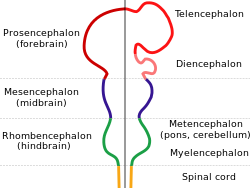间脑
此条目翻译品质不佳。 (2023年11月6日) |
间脑(英语:diencephalon)是位于端脑与中脑之间的脑组织,属于前脑的一部分(后部);间脑呈楔形,大部分被端脑所覆盖且被夹在两侧大脑半球之间,仅其腹侧部的结构露于端脑底面。
| 间脑 | |
|---|---|
 脊椎动物胚胎脑的主要分部图。神经管分化为前脑,中脑和后脑结构;前脑再进一步发育成端脑和间脑两部分 | |
 | |
| 基本信息 | |
| 发育自 | Prosencephalon, derived from the neural tube |
| 属于 | 人脑 |
| 组成 | 上丘脑、丘脑、下丘脑和底丘脑 |
| 标识字符 | |
| 拉丁文 | diencephalon |
| MeSH | D004027 |
| NeuroLex ID | birnlex_1503 |
| TA98 | A14.1.03.007、A14.1.08.001 |
| TA2 | 5661 |
| TH | H3.11.03.5.00001 |
| FMA | FMA:62001 |
| 格雷氏 | p.807 |
| 《神经解剖学术语》 [在维基数据上编辑] | |
间脑下方与中脑相连,间脑两外侧为内囊;左右间脑之间的矢状窄隙为第三脑室,左右间脑的内侧面则构成第三脑室的侧壁[1]。间脑可细分为丘脑(背侧丘脑[2])、底丘脑(腹侧丘脑[3])、上丘脑(丘脑上部)、下丘脑(丘脑下部)、后丘脑(丘脑后部)五部分[4][5][6]。
后丘脑包括内侧膝状体和外侧膝状体。上丘脑包括松果体、缰三角、缰连合、丘脑髓纹和后连合。下丘脑包括视前区、视上区、结节区和乳头体区[7][8]。
功能
编辑间脑是脊椎动物胚胎神经管中,产生后前脑结构的部分,包括丘脑、下丘脑、上丘脑(含松果体)、底丘脑、后丘脑等[4]。下丘脑执行大量的重要功能,其中大部分直接或间接与通过其他脑区和自主神经系统调节与内脏活动有关,枢神经间脑有助于控制感觉和本能行为。
间脑综合征
编辑间脑综合征的特征是一种天生罕见拥有发育停滞神经系统的疾病。尽管生理正常或略有减少热量摄入、运动机能亢进、和亢奋感,皆有严重消瘦的现象。皮肤苍白不太常见,无贫血、低血糖和低血压[医学 1]。间脑综合征可能会影响到自身的成长,也可能导致致命的原因,未能成长茁壮的幼儿平均只有七个月的年龄[医学 1]。值得注意的是该症状不与发育迟缓有关,而是与脑积水有关[医学 2]。
间脑综合征于1951年由罗素首次介绍[9]。虽然因为有过多的β促脂解素的分泌[医学 1]和代谢需求整体上升[医学 3],使不适当高的生长激素释放已被提出[医学 4],但是位于下丘脑 - 光视交叉区,通常会引起如低级别胶质瘤或星形细胞瘤的脑肿瘤,然而尚未了解到如何影响到食欲和新陈代谢所引起的间脑综合征。
相关图片
编辑-
图片描绘脊椎动物胚胎大脑的主要结构的细节。这些区域分成大脑、中脑和后脑的结构。
-
10.2毫米人类周围神经的构造(标签间脑位于左侧)。
参考资料
编辑书籍、网站资源
编辑- ^ Diencephalon and Third Ventricle - Textbook of Clinical Neuroanatomy, 2 ed.. doctorlib.info. [2021-04-03]. (原始内容存档于2022-09-26) (英语).
- ^ 存档副本. [2024-03-14]. (原始内容存档于2024-03-14).
- ^ 存档副本. [2024-03-14]. (原始内容存档于2024-03-14).
- ^ 4.0 4.1 11.6A: Functions of the Diencephalon. Medicine LibreTexts. 2018-07-20 [2021-04-03]. (原始内容存档于2021-12-24) (英语).
- ^ Jacobson & Marcus. Neuroanatomy for the Neuroscientist. Springer. 2008: 147. ISBN 978-0-387-70970-3.
- ^ 中樞神經系統. 香港体育教学网. 2013年5月10日 [2015年8月21日]. (原始内容存档于2020年2月4日).
- ^ Singh, Vishram. Textbook of Clinical Neuroanatomy 2nd. Elsevier Health Sciences. 2014: 134 [2024-03-14]. ISBN 9788131229811. (原始内容存档于2024-03-14).
- ^ 存档副本. [2024-03-14]. (原始内容存档于2024-03-14).
- ^ Russell A. A diencephalic syndrome of emaciation in infancy and childhood. Arch Dis Child. 1951, 26: 274.
医学资源
编辑- ^ 1.0 1.1 1.2 Kim A, Moon JS, Yang HR, Chang JY, Ko JS, Seo JK. Diencephalic syndrome: a frequently neglected cause of failure to thrive in infants. Korean J Pediatr. Jan 2015, 58 (1): 28–32. PMID 25729396.
- ^ Fleischman A1, Brue C, Poussaint TY, Kieran M, Pomeroy SL, Goumnerova L, Scott RM, Cohen LE. Diencephalic syndrome: a cause of failure to thrive and a model of partial growth hormone resistance. Pediatrics. June 2005, 115 (6): 724–6. PMID 15930202.
- ^ Vlachopapadopoulou E, Tracey KJ, Capella M, Gilker C, Matthews DE. Increased energy expenditure in a patient with diencephalic syndrome. J Pediatr. June 1993, 112 (6): 922–4. PMID 8501572.
- ^ Drop SL, Guyda HJ, Colle E. Inappropriate growth hormone release in the diencephalic syndrome of childhood: case report and 4 year endocrinological follow-up. Clin Endocrinol (Oxf). August 1980, 13 (2): 181–7. PMID 7438472.